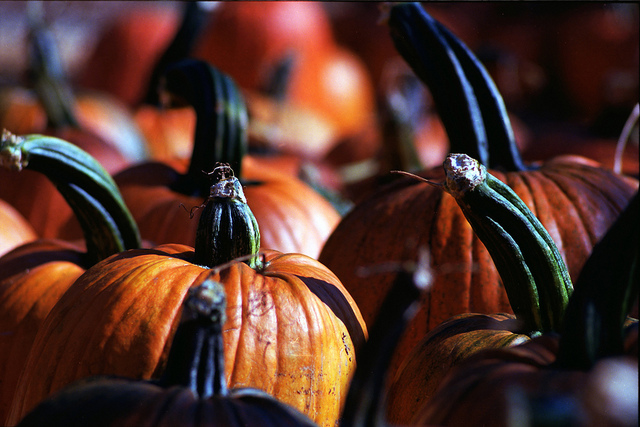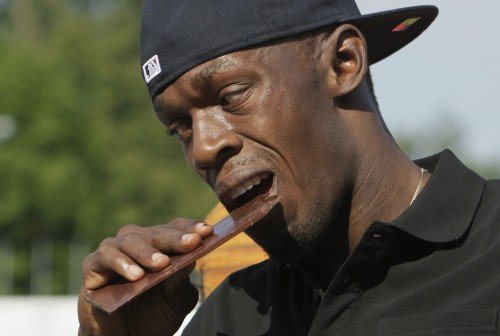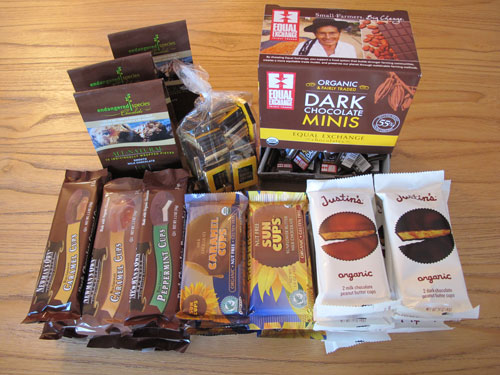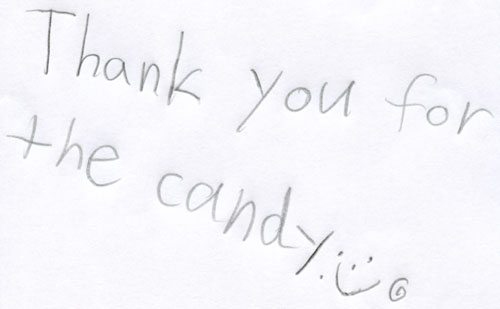Droolworthy chocolate and food studies events calendar
I was green with envy last weekend as tweets and Facebook posts poured in with updates from the Northwest Chocolate Festival in Seattle, WA. While I’ve never attended the festival, the largest gathering of bean-to-bar chocolate makers in the United States, it has been on my wish list since I started blogging. The schedule is packed with what look like excellent events — tastings, lectures, demonstrations, film showings, and just plain fun — many led by experts from the chocolate world. You can view the impressive line-up here [pdf]. Social media allowed many of us to experience the festival vicariously, at least in part. Check out the festival’s Facebook and Twitter pages or watch the trailer below to get a sense for the action.
The social media extravaganza surrounding the festival reminded me of how often I receive queries about chocolate and food events here at the blog. I keep a Google calendar of these events for my own reference and have decided to make it public via the “events” link on the top right of this page. There, you’ll find an ever-growing list of events in the chocolate and food studies world. A heavy emphasis is placed on events in the New England area where I live, but readers who live in other regions can still often find options closer to their own homes. Inclusion of an event on the list does not mean that I endorse the event or that I will attend it myself, but rather that I’ve identified it as a potential site for learning and research worth sharing with a larger audience. I strongly recommend double-checking all details with the hosting institution for each event, as I cannot regularly check for changes related to cancellations, etc, and some events do require entrance fees and/or early registration.
I’ll be working on the events page over the next few weeks to make it even more user friendly, hopefully with a dynamic map to aid in finding events in specific regions. In the meantime, I warmly welcome submissions of event recommendations. To fellow residents of the New England area — we’re fortunate to find ourselves in the midst of an especially vibrant food events scene. If you’re not hungry now, you will be soon!
Chocolate Olympics 2012

Jamaican runner Usain Bolt strikes his signature lightning bolt pose with Olympic mascot Wenlock and mini-stuffed-Wenlock after winning gold in the 100m.
If you were like me and followed the London 2012 Olympics with great enthusiasm, chances are that you’re feeling a bit of a void in your life now that the Games are over. So here’s a retrospective of a story that NBC didn’t cover: the chocolate Olympics.
Chocolate sponsorship
Kraft/Cadbury was an “official sponsor” and the “official treat provider” for the London games, the only chocolate company allowed that status (Mars was the “official chocolate” of Beijing 2008), and launched a 50 million pound marketing campaign as a result. The campaign included printing the London 2012 logo on Cadbury products, selling chocolates made in the shape of the rather odd Olympic mascots, and crafting a social media strategy to amp up support for Great Britain’s athletes.
In typical Cadbury fashion, the marketing was quirky. The interactive online tool “The Cadbury Choculator” allows users to generate Games statistics in chocolatey measurements. For example, I learned that “The London 2012 Olympic Swimming pool is 208 wonderful Cadbury Dairy Milk bars wide” and “In Olympic Trampolining the gymnasts perform tricks at whopping 500 Cadbury Crunchie bars high.”
Cadbury also returned to its stop motion Crème Egg video style for the Games with an Olympic-themed “Let the Goo Games Begin” campaign:
Other chocolate companies were unofficially involved with the Games, by sponsoring athletes as “brand ambassadors,” setting up treat stands around London, and releasing products in “the spirit of” the Olympics. Regulations around the use of the Olympic symbols are strict, though, and unsanctioned uses, like those of bakers making bagels or cakes displaying the Olympic rings, were subject to accusation of trademark infringement. But, as is often the case, there were ways around the rules, and people who knew where to ask could still find plenty of chocolate diversity thanks to the thriving black market in the Olympic Park.
Chocolate and fitness
One aspect of the chocolate Olympics merits further discussion than it got in the mainstream press this year — the ethics of promoting candy to children, especially when linking it with fitness. While many enjoy debating the efficacy of advertising regulations, there is significant evidence demonstrating the harmful health consequences of advertising to kids. Cadbury seems to have chosen a different strategy this year due to bad press around childhood obesity in the past, focusing its marketing push on game-playing rather than chocolate consumption. Still, plenty of marketing to kids took place during the Olympics and will continue in the future, and some of it included chocolate.
The average person should never model their diet after elite athletes who eat up to 12,000 calories a day to keep up with their workout regime. The vast majority of us simply don’t move around enough to need that much food. It’s therefore all the more unfortunate that the sponsorships elite athletes rely on to support themselves financially so often compromise basic nutritional wisdom. (Even American swimmer and eleven time Olympic medalist Ryan Lochte sought out a healthier training diet after feeling that he could have performed better in the 2008 Beijing Olympics without typical breakfasts of “two or three McDonald’s egg McMuffins, some hashbrowns and maybe a chicken sandwich.”)
Several USA Swimming team members hawk chocolate milk for big bucks from the Refuel With Chocolate Milk campaign. I’d need to swim for 30 minutes to burn off the calories in the average serving of low-fat chocolate milk, and the sugar content is as high as in many sodas. Even beloved Massachusetts-based Team USA gold medal winning gymnast Aly Raisman is selling chocolate milk as “the best combination of carbohydrates and protein” for post-workout muscle recovery. Given the excessive sugar content, poor quality of the chocolate, and the mounting evidence against heavy milk consumption for health, the suggestion that this is an ideal post-workout drink for an average person is absurd.
Olympian love for chocolate
Of course, it wasn’t all marketing and sponsorships at the chocolate Olympics. Several Olympians went on the record about their love for chocolate “just because.” Great Britain’s medal winning triathletes the Brownlee brothers have been inspired by chocolate since childhood, Great Britain’s gold medalist heptathlete Jessica Ennis looks forward to splurging on chocolate on her weekly cheat days during training, the USA’s all around gymnastics gold medalist Gabby Douglas enjoys “all kinds of chocolate,” and India’s medal winning badminton player Saina Nehwal said “I’m going to eat a lot of chocolate now. It’s okay if I put on some weight,” when asked what her plans were after the Games. Team USA’s lightweight rower, Nick LaCava, who is 6’3″ tall and, incredibly, weighs in at 156 pounds on race days, has a chocolate business background. He was a co-founder of customizable chocolate bar company Chocomize before living out his Olympic dream.
Let’s keep it real
The oldest Olympic torch bearer at these Games, 100-year-old Diana Gould, shared the key to long life with the UK’s Telegraph. According to her century of wisdom, one can live a long and happy life with a good attitude, healthy habits that include lots of walking, and a bit of chocolate each day.
Usain Bolt was awarded a huge chocolate bar in the Czech Republic’s Golden Spike athletics event in May 2012 and went on to win three gold medals in the London Olympics (there’s a cute video of tiny children racing against him and then sharing chocolate here). As delicious as that chocolate might have been, it was not responsible for making him the fastest man in the world. Twice. Nor should chocolate companies suggest that it was.
Wacky World of Choc Wednesdays: Cadbury Dairy Milk Thumbs Up
How’s this for the wacky world of choc?
Cadbury Dairy Milk brand, which has a long history of trying to outdo itself with lively stunts and advertisements, recently launched a fan appreciation campaign in celebration of reaching one million fans on its UK Facebook page. So what did they do this time? They commissioned a crew of trademarked-Cadbury-purple-clad sculptors to fashion a giant thumbs up version of the Facebook “Like” button out of 3 tons of Cadbury Dairy Milk bars. Then they broadcast the whole shabang via Facebook livestream over the course of fourty-eight hours.
Here’s a short video (just over one minute long) detailing the building process:
Cadbury donated all the chocolate to a company working to develop renewable fuels, where scientists will use it to continue their research. Clearly, research on chocolate is where it’s at.
Itching to see more of Cadbury’s stunts? You can head over to the brand’s UK Facebook page to check out the 30 foot tall Magnificent Musical Chocolate Fountain they’ve got going on in magical Joyville right now. Or check out this past Bittersweet Notes post on Chocolate Stop Motion Videos for an example of one of Cadbury’s stickier ad campaigns.
And while you’re at it, readers, visit Bittersweet Notes’ fledgling Facebook page and “Like” away for chocolatey updates in your News Feed. I promise to do something insane when the page reaches 1 million fans.
Bittersweet Notes and The Root: Chocolate’s Bittersweet Legacy

Halloween pumpkins at the field by DeusXFlorida
This morning, The Root published a piece I wrote entitled Chocolate’s Bittersweet Legacy. In the article, I detail labor abuses in West African cacao cultivation, the chocolate industry’s decades long inaction on the problem, and recommended responses for consumers who want to make a difference. I hope that you’ll check it out.
Two related posts on my blog are:
- Ethical Halloween Candy 2011, which offers a comprehensive list of fairly traded alternative Halloween chocolate candies with recommendations on where to buy and price comparisons, and
- Ethical Halloween Candy 2011 Taste Test Results, which details the results of a taste test survey of many of these fairly traded candies.
If you’re not familiar with The Root, I also recommend browsing through some of the other articles and blogs when you visit the site. It’s a leading source of online news and commentary from an African American perspective and one of my regular reads.
Happy Halloween!
Ethical Halloween Candy 2011 Taste Test Results

Trick or Treat! by Jason Paluck
A few weeks ago, I posted a long list of ethical Halloween chocolate candy alternatives. Because these alternative candies are unfamiliar to many, I sent samples out to a small army of kid and adult taste testers to ask their opinions. My goals were to get a sense for how kids and adults react to candy that is new and different and to see if they would even like these lesser known ethical alternatives.
In short, there’s good news. Our tasters ranked several fairly traded alternative candies superior to traditionally popular brands lacking ethical sourcing. Some concerns were raised about availability, package design, candy size, and price points, but the results of this taste test were largely successful.
The totally-unscientific-yet-super-delicious survey design went something like this:
I sent the survey out to 8 families, 24 people total. Each family received 5-6 types of candy to try. I asked each person in the family to rate each candy as “Yummy,” “OK,” or “Gross.” I also included a few questions:
- “How does this candy compare to other peanut butter cups/milk chocolate squares/peppermint patties that you’ve had?”
- “Do you like the packaging?”
- “Is the candy too big or too small for Halloween?”
- “What is your favorite candy that you tried today?”
- “What is your favorite candy in the whole world?”
Kids included in the survey ranged in age from 2 to 10. I sent it to kids who can’t get enough sugar, kids who would choose a chicken drumstick over a candy bar any day, kids who don’t like chocolate, kids who eat mostly pickles, and kids who can’t stand peanut butter. Adults ranged from 25 to, well, let’s say over 50. (*wink*) The adults were a mix of the candy apathetic and self professed chocoholics, some firmly in the milk chocolate camp and others insisting that only dark can satisfy their needs.
Here’s what we learned.
On the plus side:
- Unsurprisingly, everyone was excited to try this candy. One survey respondent, upon learning that the candy was en route, wrote: “Nom nom nom. Excitement building.”
- The simple act of participating in this survey got people talking about ethical chocolate in a way that they hadn’t before. Several parents commented on their children’s shocked reactions to the problem of forced, trafficked, and child labor in West Africa. One proud father wrote: “We absolutely tried ALL the chocolates — loved most of it…. AND we are buying ETHICAL Halloween candy this weekend from Whole Foods!!” Another parent explained that his six year old daughter felt so strongly about the issue that she took it upon herself to organize the family’s tasting and to tell all of her friends at school to look for fair trade candy from now on.
- Every family reported back that this was a fun exercise in taste, marketing, and ethics to enjoy as a group. “It really gets you thinking about the chocolate that we buy out of habit and what other chocolate we might just pass by,” explained one participant. One family even suggested that their kids, while typically reluctant to try new things, were excited enough about the tasting event that they happily ripped into everything with gusto.
- We also found candies that survey respondents preferred to their Hershey’s counterparts. Yum! More on the favorites below.
However, there were some challenges:
- Both kids and adults reported difficulty in comparing the taste of ethical candy alternatives to better known traditional candies. A mother of two wrote that, while often delicious, the candies were just plain different: “It is difficult to rate the candy because unfortunately we compare it to well know commercially sold candy that has been around forever.”
- Several adult survey respondents were concerned about price. “We sometimes have over 100 trick-or-treaters,” one participant told me, “so we have to keep costs as low as possible.”
- Several kids reported back that they didn’t find the packaging for the ethical candies to be very fun. A ten year old respondent and his mother said that some of the candy packaging “could use a facelift.” Another parent described the majority of the candy packaging as “boring and unappealing.”
- There were negative taste ratings on certain candies. Taste is an individual, subjective affair, and one product can’t please everyone all of the time. In addition, it goes to show that even when candy is ethically sourced, quality production and excellent taste are not a guarantee. More on the taste disappointments follows.
The absolute favorite candies were, in order of popularity:
- Justin’s Nut Butter Peanut Butter Cups: Several survey respondents ranked these among “the best peanut butter cups” they had ever had, and all but a few rated them significantly higher than Reese’s peanut butter cups. Parents wished that the candies were available in single servings as opposed to doubles.
- Equal Exchange 55% minis: Almost all survey respondents absolutely loved these; only a few of the kids found the chocolate to be “a bit bitter.” One young lady carefully practiced her newly mastered penmanship, writing “The Equal Exchange is awesome.” The adult tasters said that they enjoyed the complexity of chocolate, even identifying flavors of “cinnamon, caramel, and other spices.” Most kids said that these candies were too small, while most adults said that they were perfectly sized for trick-or-treaters. Go figure.
- Endangered Species Milk Chocolate Halloween Treats: These candies were widely popular among both kids and adults, with many people remarking that they found them “not too sweet,” and “refreshingly less sweet than Hershey’s.” The packaging, however, did not appeal to many.
- Newman’s Own Organics Peanut Butter Cups: These peanut butter cups came in at a close second to Justin’s and were a big crowd pleaser. Most parents agreed that they would prefer to buy these candies as singles, rather than in the usual package with three cups.
Among almost all adults and a few adventurous kids, the Michel Cluizel, Pralus, and Askinosie were extremely popular. Several of the adults, having tried these brands for the first time, said that they would seek them out in the future, intending to have them on hand for when they “need a serious chocolate fix.” One mother described the Cluizel as “some of the most complex chocolate I have ever had.” Another survey participant could not wait to try more of the single origin bars from Pralus and Askinosie. These three brands, while perhaps not widely known at a major commercial level, are from well respected high quality chocolate makers, so this does not come as a surprise.
The Newman’s Own Organics Peppermint Cups and Caramel Cups and Sun Cups Caramel and Sunflower Chocolate Cups were all well liked by more than half of the survey respondents, but were subject to individual taste preferences. For example, some participants do not like peppermint or caramel with chocolate. Those who liked them shared the refrain “We want more!” Others said that they enjoyed the Sun Cups Sunflower Chocolate Cups, but that, because they have the option, they prefer to eat peanut butter cups instead.
Some candies were ranked as needing improvement:
- Sun Cups Mint Chocolate Cups: Most survey respondents described these candies as too sweet and found the peppermint oil flavor too strong. The chocolate was criticized for being grainy, with a poor texture.
- Divine 70% Dark Chocolate Bites: Most survey respondents found the chocolate flavor in these bars to be too intense, with a long and somewhat unpleasant aftertaste. They also described the texture as “too waxy.”
(Note: We didn’t get to try all of the candies on the list due to time and budget constraints. I can say from personal experience, though, that I have previously enjoyed Sjaak’s, Chuao Chocolatier, and Sweet Riot’s tasty treats. They certainly merit further exploration in chocolate tasting adventures.)
All in all, this was a fun and educational exercise. Thanks so much to the wonderful survey participants — to the wicked awesome kids who so graciously suffered through the eating of ridiculous amounts of candy to help me out, and to the kind, patient parents who supervised the filling out of the surveys and the resulting sugar highs. You’re the best!
Update (October 31, 2011): Visit The Root to read more of my thoughts on this topic: Chocolate’s Bittersweet Legacy.
Happy Halloween!






